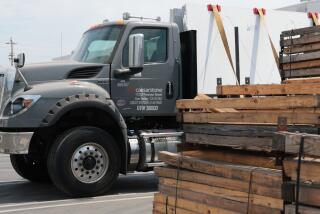Bigger and Boulder : Buyers Want a Look Thatâs Set in Stone
Stone has come down from the mountain and into the mainstream.
Like outdoor lighting systems, wrought-iron fencing, tile roofs and other design touches that once were limited to the homes of the well-to-do, now fancy flagstone terraces, walkways of square-cut sandstone, imposing rock walls and artfully built stone waterfalls are with increasing frequency finding their way into middle-class tract developments.
âPeople want stone because it looks natural, and it looks rich,â says Craig Maietta, marketing vice president for Sepulveda Building Supplies in Laguna Niguel, one of the largest stone and rock retailers in the county.
He figures he sells close to 400 tons of rock and stone a month, much of it destined for mid-price developments where homeowners are constantly on the prowl for some way to make their abodes stand out.
Ironically, it is the development of realistic faux stone products--made of molded lightweight concrete--that has driven the popularity of real rock.
Faux stone has given Southern Californiaâs tract-home builders a product that can add a touch of luxury to the plainest of stucco boxes yet is relatively inexpensive and easy to apply. Lightweight imitation stone is made to mimic everything from granite boulders for big landscape accents to flagstone and river rock veneers for walls and pillars.
Builders use it, and people like it.
âPeople want to match [in their yard] the look the developer gave their home,â Maietta says. âThatâs what is driving the use of real stone in landscaping.â
*
Stone is also desirable, says rock maven Gary Huddleston of Country Garden Nursery in Placentia, because it goes with virtually any architectural style, even glass houses. It also fits every landscape design and is one of the most durable of the natural building materials.
For most of the late 20th century, though, stone has pretty much been a designer touch for the well-to-do because it is the most labor intensive of all the masonry products and, thus, the most costly.
When the typical Southland tract home was on a 7,200-square-foot lot, it would have taken a lot of rock to make an impression--more than most people could afford. So stonework remained a symbol of affluence.
But the downsizing of the middle-class homestead, combined with a construction industry crunch that forced skilled tradespeople, including stonemasons, to lower prices, started changing things about five years ago.
âOrdinary people can afford to use stone to accessorize now because they donât have to use as much of it as they once would have,â says Huddleston, who has been selling landscape rocks for 24 years and has seen the market âjust explodeâ in the past five.
Stone hasnât gotten cheaper, but the price has pretty much stabilized. And quarries, seeing the demand, have improved extraction methods so that production has increased without a matching hike in costs.
Now half a dozen large builder-supply companies in Orange County are devoting huge sections of their lots to stone and stone products.
A walk through a mid-priced subdivision in the Belmont development off Via Escola in Orange gives testimony to the growing popularity of stonework.
The builder used manufactured stone veneer to trim 20 of the 68 homes in the 2-year-old tract. Since moving in, owners of 25 of the homes have used real stone in their landscaping schemes.
There are stone walkways--several of irregular rose-colored Arizona flagstone, one of dark and shiny slate and one of buff-colored sandstone cut into foot-square tiles.
There are flagstone planters; a curving, stone-faced low wall that gives privacy to a front courtyard; a host of sidewalk and frontyard lamps with stone bases and one low planter wall made of granite blocks.
Several backyards feature large flagstone patios--some mortared into place atop concrete slabs, others placed loose on a base of sand.
One backyard features a free-form flagstone patio in several shades of rose and tan, connected by a curving walkway of natural stepping stones to a circular flagstone terrace at the back of the lot. In between patio and terrace is a stone-rimmed fish pond fed by a small, three-tier waterfall made of carefully fitted sandstone boulders.
A few houses down the street, the backyard features an imposing fireplace of blue-toned Bouquet Canyon flagstone, from Arizonaâs Bouquet Canyon quarry.
And no, it is not a backyard barbecue or a fire pit. It is a full-sized fireplace, complete with chimney, hearth and a curving stone seat-wall that ties it into a raised patio trimmed in the same flagstone.
*
It might seem a little eccentric to build a fireplace just outside a family room that already contains one. But Tina and Andy Jones said they love to entertain and wanted an outdoor setting that made their friends feel like they were at home in their own living rooms.
The fireplace does that while also providing most of the light and heat needed to keep a party going into the night, even in late fall and early spring.
A stone fireplace was more expensive than a brick one, but the Joneses, who also used the blue-gray stone for a front porch and to trim their concrete front walk, said they were drawn to the natural beauty of stone.
Like most people, the Joneses used a contractor to do their stonework. It isnât a big do-it-yourself area because most jobs with rock require skill, muscle and a lot of patience. Besides being heavy, the natural material doesnât come conveniently sized to plop in place. Most stone has to first be trimmed with special chisels or expensive diamond-bladed saws.
Even real stone tiles, which come cut into squares and rectangles, only come in about even shapes, sizes and thickness.
A skilled do-it-yourselfer, armed with patience, the right tools and knowledge gleaned from books such as âSunset Basic Masonry Illustratedâ and from stone specialists at materials yards such as Sepulveda and Country Garden, can do a credible job with patios, walks, waterfalls and small walls.
But those who go it alone are a minority, stone sellers say. The expense of the material and the tools needed to work with it argue against most trying elaborate stonework projects on their own.
Do-it-yourself projects, Huddleston and others in the stone business said, most often are those that involve placing rocks and small boulders into gardens as accent pieces or building small waterfalls and fountains.
âWe sell a lot of individual rocks, as well as small orders of flagstones for stepping stones, pond rims and dry-stack walls. Otherwise, most of our customers are either contractors or homeowners coming in to pick out the stone they are going to have their contractor install.â
*
Whether doing it yourself or having a contractor do it for you, one thing to remember about using rocks and boulders in landscape schemes is that rarely in nature are rocks entirely aboveground. Rocks look best when at least a third of their mass is buried.
Other stone projects rely on a good eye for balance--so the irregular shapes, sizes and shades are placed to complement the overall design--and a careful approach to installing, especially if the stone is being mortared into place. Mortar must be cleaned up with ample water before it starts to harden. Otherwise it can stain the stone.
In landscaping, stone specialists say, rocks and flagstones usually look best when softened by plant material--a row of flagstone stepping stones can have pretty stark appearance when left sitting surrounded by dirt or gravel.
But plant some fragrant chamomile or other dense green ground cover between the stones and in six months to a year their appearance will soften as the plant material creeps up over the sharp edges. The stones and plants will combine to make the walkway look as if it has been there a hundred years.
Finding stone, once a chore that sent many a homeowner trekking to Arizona or into Mexico, has become pretty easy. About a dozen large building-material supply yards in Orange County have big inventories of stone. Almost all carry a wide selection of flagstone--the most popular rock--and sell it by the piece or by the ton (prices range from $150 to $600 a ton, depending on color, quality and thickness).
Most also carry gravels, pebbles and boulders, although the broadest selection of that type of rock may be at Huddlestonâs nursery in Placentia.
There, the family-owned nursery has carved out a niche as supplier of dozens of types of landscape stone, from turquoise streaked quartz and muted tan, brown and cream-streaked sandstones to purple and white gemstone boulders weighing in at a ton and a half or more.
Huddleston also carries nearly a dozen fancy gravels and small pebbles--in buffs, tans, blacks, browns, reds and pinks--that he sells by the bag or by the ton.
Like the homeowners he sells much of his rock to, Huddleston set out to set himself apart. As it became apparent that rock was becoming a broad consumer good, he said, he began cultivating relationships with quarries that werenât supplying other area rock yards, signing them to exclusive distributorship agreements so that rivals canât carry the same stones.
Other yards also specialize.
Thompson Building Supply in Orange carries lots of flagstone, river rock and the like but also has huge supplies of faux stone trim and some of the biggest natural boulders around.
Sepulveda augments its natural rock and stone with a large line of real stone tile--usually cut from sandstone, limestone, marble or granite into 6-, 9- or 12-inch squares.
Imperial Building Materials in La Habra carries a wide selection of granite boulders, from a few pounds to a few tons (the average price is 10 cents a pound) and was one of the first yards in the county to sell smooth, rose-tinged Arizona river rock.
To find a rock supplier that meets your needs, the best idea is to visit them all. Proximity probably wonât matter, because most stone must be delivered, and most yards charge for delivery even if your house is half a block away.
If you find a color or type of stone that you really like, buy a piece and take it to other yards to see if they can match the quality and beat the price.
Donât buy until you are perfectly satisfied with what you are getting. Rock will usually last longer than your house, so youâve got to be prepared to live with your choice.
The plus side of the equation is that, if done right, a landscape or hardscape that incorporates rock and stone is going to stay looking good with minimal maintenance for a long time.
OâDell has spent 18 months installing more than 6 tons of stone in a do-it-yourself landscaping project at his home in Orange.
More to Read
Sign up for Essential California
The most important California stories and recommendations in your inbox every morning.
You may occasionally receive promotional content from the Los Angeles Times.






